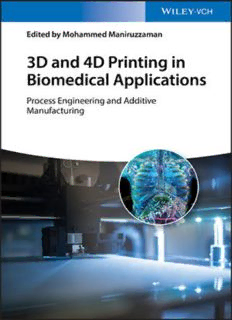Table Of Content3Dand4DPrintinginBiomedicalApplications
3D and 4D Printing in Biomedical
Applications
ProcessEngineeringandAdditiveManufacturing
Editedby
MohammedManiruzzaman
Editor AllbookspublishedbyWiley-VCH
arecarefullyproduced.Nevertheless,
Dr.MohammedManiruzzaman authors,editors,andpublisherdonot
UniversityofSussex warranttheinformationcontainedin
SchoolofLifeSciences thesebooks,includingthisbook,to
BN19QGBrighton befreeoferrors.Readersareadvised
UnitedKingdom tokeepinmindthatstatements,data,
illustrations,proceduraldetailsorother
Cover itemsmayinadvertentlybeinaccurate.
3DPrinter©iStock.com/AzmanL
HumanAnatomy©courtesyofLuciano LibraryofCongressCardNo.:
PaulinoSilva&createdbyEllaMaru appliedfor
Studio
BritishLibraryCataloguing-in-Publication
Data
Acataloguerecordforthisbookis
availablefromtheBritishLibrary.
Bibliographicinformationpublishedby
theDeutscheNationalbibliothek
TheDeutscheNationalbibliotheklists
thispublicationintheDeutsche
Nationalbibliografie;detailed
bibliographicdataareavailableonthe
Internetat<http://dnb.d-nb.de>.
©2019Wiley-VCHVerlagGmbH&
Co.KGaA,Boschstr.12,69469
Weinheim,Germany
Allrightsreserved(includingthoseof
translationintootherlanguages).No
partofthisbookmaybereproducedin
anyform–byphotoprinting,
microfilm,oranyothermeans–nor
transmittedortranslatedintoa
machinelanguagewithoutwritten
permissionfromthepublishers.
Registerednames,trademarks,etc.used
inthisbook,evenwhennotspecifically
markedassuch,arenottobe
consideredunprotectedbylaw.
PrintISBN:978-3-527-34443-7
ePDFISBN:978-3-527-81367-4
ePubISBN:978-3-527-81369-8
oBookISBN:978-3-527-81370-4
Typesetting SPiGlobal,Chennai,India
PrintingandBinding
Printedonacid-freepaper
10 9 8 7 6 5 4 3 2 1
Thebondbetweenfatheranddaughter
happensinstantly,startingrightatbirth.
Whenafatherfirstlayseyesonhislittlegirl,
Heloveshermorethananythingonthisearth.
(H.Twining)
Tomywonderfullittledaughter
ShahroozMyreenZaman
vii
Contents
Preface xvii
1 3D/4DPrintinginAdditiveManufacturing:Process
EngineeringandNovelExcipients 1
ChristianMuehlenfeldandSimonA.Roberts
1.1 Introduction 1
1.2 TheProcessof3Dand4DPrintingTechnology 1
1.3 3D/4DPrintingforBiomedicalApplications 2
1.4 SmartorResponsiveMaterialsfor4DBiomedicalPrinting 3
1.5 Classificationof3Dand4DPrintingTechnologies 7
1.5.1 FusedFilamentFabrication(FFF)–Extrusion-BasedSystems 7
1.5.2 PowderBedPrinting(PBP)–Droplet-BasedSystems 10
1.5.3 Stereolithographic(SLA)Printing–Resin-BasedSystems 12
1.5.4 SelectiveLaserSintering(SLS)Printing–Laser-BasedSystems 15
1.6 ConclusionsandPerspectives 17
References 17
2 3Dand4DPrintingTechnologies:InnovativeProcess
EngineeringandSmartAdditiveManufacturing 25
DeckTan,AliNokhodchi,andMohammedManiruzzaman
2.1 Introduction 25
2.2 Typesof3DPrintingTechnologies 25
2.2.1 Stereolithographic3DPrinting(SLA) 25
2.2.2 Powder-Based3DPrinting 26
2.2.3 SelectiveLaserSintering(SLS) 27
2.2.4 FusedDepositionModeling(FDM) 28
2.2.5 SemisolidExtrusion(EXT)3DPrinting 29
2.2.6 ThermalInkjetPrinting 30
2.3 FDM3DPrintingTechnology 31
2.3.1 FDM3DPrintingApplicationsinUnitDoseFabricationsand
MedicalImplants 33
2.4 HotMeltExtrusionTechniquetoProduce3DPrintingPolymeric
Filaments 34
viii Contents
2.5 SmartMedicalImplantsIntegratedwithSensors 35
2.5.1 ExamplesofMedicalImplantswithSensors 36
2.6 4DPrintingandFuturePerspectives 38
2.6.1 4DPrintingandItsTransitioninMaterialFabrication 38
2.6.2 ShapeMemoryorStimuli-ResponsiveMechanismof4DPrinting 39
2.6.3 FactorsAffecting4DPrinting 40
2.6.3.1 Humidity-ResponsiveMaterials 40
2.6.3.2 Temperatures 41
2.6.3.3 ElectronicandMagneticStimuli 43
2.6.3.4 Light 45
2.6.4 FuturePerspectivesof4DPrinting 45
2.7 RegulatoryAspects 46
2.8 Conclusions 48
References 48
®
3 3DPrinting:ACaseofZipDose Technology–World’sFirst3D
PrintingPlatformtoObtainFDAApprovalforaPharmaceutical
Product 53
ThomasG.WestandThomasJ.Bradbury
3.1 Introduction 53
3.2 Terminology 53
3.3 HistoricalContextforThisFormof3DPrinting 54
®
3.4 ZipDose Technology 56
3.5 3DPrintingMachinesandPharmaceuticalProcessDesign 60
3.5.1 Overview 60
3.5.2 GeneralizedProcessinthePharmaceuticalContext 62
3.5.3 Exemplary3DPMachineDesigns 65
®
3.6 DevelopmentofSPRITAM 70
3.6.1 ProductConceptandNeed 70
3.6.2 RegulatoryApproach 71
3.6.3 IntroductionoftheTechnologytoFDA 72
3.6.4 TargetProductProfile 72
3.6.5 SynopsisofFormulationandClinicalDevelopment 73
3.7 Conclusion 76
Acknowledgments 77
References 77
4 ManufacturingofBiomaterialsviaa3DPrintingPlatform 81
PatrickThayer,HectorMartinez,andErikGatenholm
4.1 AdditiveManufacturingandBioprinting 81
4.2 Bioinks 83
4.2.1 PrintabilityControl–BioinkCompositionandEnvironmental
Factors 83
4.2.2 MechanismsforFilamentFormationandStability 85
4.3 3DBioprintingSystems 87
4.3.1 MultifacetedSystems 88
Contents ix
4.3.2 MajorComponents 88
4.3.3 PneumaticPrinthead 89
4.3.4 MechanicalDisplacementPrinthead 89
4.3.5 InkjetPrinthead 91
4.3.6 HeatedandCooledPrintheads 91
4.3.7 High-TemperatureExtruder 92
4.3.8 MultimaterialPrinthead 92
4.3.9 HeatedandCooledPrintbed 94
4.3.10 CleanChamberTechnology 94
4.3.11 Video-CapturePrintheadandSensors 94
4.3.12 IntegratedIntelligence 95
4.4 Applications 95
4.4.1 InternalArchitecture 96
4.4.2 IntegratedVascularNetworksandMicrostructurePatterning 98
4.4.3 PersonalizedMedicine 99
4.5 StepsNecessaryforBroaderApplication 101
References 102
5 Bioscaffolding:ANewInnovativeFabricationProcess 113
RaniaAbdelgaber,DavidKilian,andHendrikFiehn
5.1 Introduction:FromBioscaffoldingtoBioprinting 113
5.2 Scaffolding 115
5.2.1 PropertiesofScaffolds 115
5.2.2 BioprintersvsCommon3DPrinters:ApproachesforExtrusionof
Polymers 116
5.2.3 ComparingCellSeedingTechniquesto3DBioprintingorCell-Laden
Hydrogels 117
5.2.3.1 FromPrintingtoBioprinting 117
5.2.3.2 ApproachesofStabilizingPrintedConstructs 118
5.2.4 Examples/ApplicationsofCell-SeededScaffolds 119
5.2.5 DataProcessingof3DCADDataforBioscaffolds 119
5.3 BioprintedScaffolds 120
5.3.1 Bioinks 120
5.3.2 ToolsforMultimaterialPrinting 123
5.3.3 MultimaterialScaffold 124
5.3.4 Core–ShellScaffolds 126
5.3.5 AdditionalTechnicalEquipment 128
5.3.6 PiezoelectricPipettingTechnology 128
5.3.7 UsageofPiezoelectricInkjetTechnologywithBioscaffolds 130
5.4 ApplicationsofBioscaffolderandBioprintingSystems 132
5.4.1 IndividualizedImplantsandTissueConstructs 132
5.4.2 GreenBioprinting 133
5.4.3 ChallengesforClinicalApplicationsofBioprintedScaffoldsinTissue
andOrganEngineering 134
5.4.4 4DPrinting 135
5.5 Conclusion 137
References 137
x Contents
6 Potentialof3DPrintinginPharmaceuticalDrugDeliveryand
Manufacturing 145
MarenK.Preis
6.1 Introduction 145
6.2 PharmaceuticalDrugDelivery 145
6.3 ConventionalManufacturingvs3DPrinting 146
6.4 AdvancedApplicationsforImprovedDrugDelivery 148
6.5 Instrumentations 148
6.6 Locationof3DPrintingManufacturing 149
6.6.1 PharmaceuticalIndustry 149
6.6.2 AtthePointofCare 150
6.6.3 Print-at-Home 150
6.7 RegulatoryAspects 151
6.8 Summary 151
References 151
7 Emerging3DPrintingTechnologiestoDevelopNovel
PharmaceuticalFormulations 153
ChristosI.Gioumouxouzis,GeorgiosK.Eleftheriadis,and
DimitriosG.Fatouros
7.1 Introduction 153
7.2 FDM3DPrinting 153
7.3 Pressure-AssistedMicrosyringe 173
7.4 SLA3DPrinting 175
7.5 PowderBed3DPrinting 175
7.6 SLS3DPrinting 178
7.7 3DInkjetPrinting 179
7.8 Conclusions 180
References 180
8 ModulatingDrugReleasefrom3DPrintedPharmaceutical
Products 185
JulianQuodbach
8.1 Introduction 185
8.2 PharmaceuticallyUsed3DPrintingProcessesand
Techniques 186
8.2.1 ProcessFlowof3DPrintingProcesses 186
8.2.2 Inkjet-BasedPrintingTechnologies 187
8.2.3 Extrusion-BasedPrintingTechniques 187
8.2.4 Laser-BasedTechniques 188
8.3 ModifyingtheDrugReleaseProfilefrom3DPrintedDosage
Forms 189
8.3.1 ApproachestoModifytheDrugRelease 189
8.3.2 ModifyingtheDrugReleasebyFormulationVariation 189
8.3.2.1 FusedFilamentFabrication 189
8.3.2.2 OtherPrintingTechniques 194
Contents xi
8.3.3 ManipulatingtheDosageFormGeometryasaMeanstoModify
APIRelease 195
8.3.3.1 FusedFilamentFabrication 196
8.3.3.2 Drop-on-DropPrinting 197
8.3.4 DissolutionControlviaDirectedDiffusionand
Compartmentalization 199
8.3.4.1 Drop-on-PowderPrinting 199
8.3.4.2 FusedFilamentFabrication 202
8.3.4.3 PrintingwithPressure-AssistedMicrosyringes 205
8.4 Conclusion 206
References 207
9 NovelExcipientsandMaterialsUsedinFDM3DPrintingof
PharmaceuticalDosageForms 211
MingLu
9.1 Introduction 211
9.2 BiodegradablePolyester 219
9.2.1 PolylacticAcid(PLA) 219
9.2.2 Poly(ε-caprolactone)(PCL) 220
9.3 PolyvinylPolymer 221
9.3.1 PolyvinylAlcohol(PVA) 221
9.3.2 EthyleneVinylAcetate(EVA) 223
9.3.3 Polyvinylpyrrolidone(PVP) 224
9.3.4 Soluplus 225
9.4 CellulosicPolymers 225
9.4.1 HydroxypropylCellulose(HPC) 226
9.4.2 HydroxypropylMethylcellulose(HPMC) 227
9.4.3 HydroxypropylMethylcelluloseAcetateSuccinate(HPMCAS) 228
9.5 Polymethacrylate-BasedPolymers 229
9.5.1 EudragitRL/RS 230
9.5.2 EudragitL100-55 231
9.5.3 EudragitE100 232
9.6 Conclusion 233
References 234
10 RecentAdvancesofNovelMaterialsfor3D/4DPrintingin
BiomedicalApplications 239
JasimAhmed
10.1 Introduction 239
10.2 Materialsfor3DP 240
10.3 Rheology 241
10.4 Ceramicsfor3DPrinting 241
10.5 PolymersandBiopolymersfor3DPrinting 243
10.5.1 Polylactide(PLA) 245
10.5.2 Poly(ε-caprolactone)(PCL) 245
10.5.3 HyaluronicAcid 245

